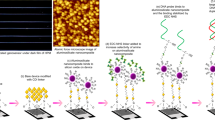Abstract
Assessment of epidermal growth factor receptor (EGFR) exon 19 mutations is very important indicator for treating lung cancer patients. In this report, we propose in-situ and highly sensitive detection method of EGFR mutation using quartz crystal microbalance (QCM) and nano-porous structured QCM electrode. The detection is based on the resonance frequency shift of QCM electrode upon DNA hybridization between probe DNA and EGFR mutant DNA (746–750 (del ELREA) in EGFR exon 19). Nano-porous structure is produced on the QCM electrode through simple processes of electrochemical deposition and etching. By using QCM, in-situ detection of EGFR mutation is performed within 30 mins. High sensitivity is achieved by introducing nano-porous structure on a QCM electrode, and the limit of detection (LOD) is 1 nM.
Similar content being viewed by others
References
S. V. Sharma, D. W. Bell, J. Settleman and D. A. Haber, Epidermal growth factor receptor mutations in lung cancer, Nat. Rev. Cancer, 7 (2007) 169–181.
B. A. Chan and J. I. G. Coward, Chemotherapy advances in small-cell lung cancer, Journal of Thoracic Disease, 5 (2013) S565-S578.
M. D. Siegelin and A. C. Borczuk, Epidermal growth factor receptor mutations in lung adenocarcinoma, Lab. Invest., 94 (2014) 129–137.
Y. Kuang et al., Noninvasive detection of EGFR T790M in Gefitinib or Erlotinib resistant non–small cell lung cancer, Clinical Cancer Research, 15 (2009) 2630–2636.
Y. Yatabe, T. Hida, Y. Horio, T. Kosaka, T. Takahashi and T. Mitsudomi, A rapid, sensitive assay to detect EGFR mutation in small biopsy specimens from lung cancer, The Journal of Molecular Diagnostics, 8 (2006) 335–341.
C.-H. Yun et al., Structures of lung cancer-derived EGFR mutants and inhibitor complexes: Mechanism of activation and insights into differential inhibitor sensitivity, Cancer Cell, 11 (2007) 217–227.
A. L. Richardson and J. D. Iglehart, BEAMing up personalized medicine: Mutation detection in blood, Clinical Cancer Research, 18 (2012) 3209–3211.
K. Taniguchi et al., Quantitative detection of EGFR mutations in circulating tumor DNA derived from lung adenocarcinomas, Clinical Cancer Research, 17 (2011) 7808–7815.
V. Taly et al., Multiplex picodroplet digital PCR to detect KRAS mutations in circulating DNA from the plasma of colorectal cancer patients, Clinical Chemistry, 59 (2013) 1722–1731.
M. U. Kopp, A. J. D. Mello and A. Manz, Chemical amplification: Continuous-flow PCR on a chip, Science, 280 (1998) 1046–1048.
X.-W. Xu et al., Detection EGFR exon 19 status of lung cancer patients by DNA electrochemical biosensor, Biosensors and Bioelectronics, 80 (2016) 411–417.
B. Eftekhari-Sis, M. A. Aliabad and F. Karimi, Graphene oxide based nano-biosensor for the detection of deletion mutation in exon 19 of EGFR gene, leading to lung cancer, Materials Letters, 183 (2016) 441–443.
Q. Liu, S. Y. Lim, R. A. Soo, M. K. Park and Y. Shin, A rapid MZI-IDA sensor system for EGFR mutation testing in non-small cell lung cancer (NSCLC), Biosensors and Bioelectronics, 74 (2015) 865–871.
J. Ladd, A. D. Taylor, M. Piliarik, J. Homola and S. Jiang, Label-free detection of cancer biomarker candidates using surface plasmon resonance imaging, Anal. Bioanal Chem., 393 (2009) 1157–1163.
K. Jang, J. Choi, C. Park and S. Na, Label-free and highsensitive detection of Kirsten rat sarcoma viral oncogene homolog and epidermal growth factor receptor mutation using Kelvin probe force microscopy, Biosensors and Bioelectronics, 87 (2017) 222–228.
G. N. M. Ferreira, A.-C. da-Silva and B. Tomé, Acoustic wave biosensors: Physical models and biological applications of quartz crystal microbalance, Trends in Biotechnology, 27 (2009) 689–697.
J. Wang, Survey and summary from DNA biosensors to gene chips, Nucleic Acids Research, 28 (2000) 3011–3016.
G. Sauerbrey, Verwendung von schwingquarzen zur wägung dünner schichten und zur mikrowägung, Zeitschrift für Physik, 155 (1959) 206–222.
J. Park, D. Bang, K. Jang, E. Kim, S. Haam and S. Na, Multimodal label-free detection and discrimination for small molecules using a nanoporous resonator, Nature Communications, 5 (2014) 3456.
E. M. V. Hoek and G. K. Agarwal, Extended DLVO interactions between spherical particles and rough surfaces, Journal of Colloid and Interface Science, 298 (2006) 50–58.
A. Shrivastava and V. Gupta, Methods for the determination of limit of detection and limit of quantitation of the analytical methods, Chronicles of Young Scientists, 2 (2011) 21–25.
K. Jang, J. Choi, C. Park and S. Na, Label-free and highsensitive detection of Kirsten rat sarcoma viral oncogene homolog and epidermal growth factor receptor mutation using Kelvin probe force microscopy, Biosensors and Bioelectronics, 87 (2017) 222–228.
Author information
Authors and Affiliations
Corresponding authors
Additional information
Recommended by Associate Editor Won Hyoung Ryu
Sungsoo Na is a Professor of Department of Mechanical Engineering at Korea University since 2001. He obtained his Ph.D. in 1997 from Virginia Tech in USA. He is interested in Sensing of Circulator Tumor DNA and Nanotoxic material.
Rights and permissions
About this article
Cite this article
Park, H., You, J., Park, C. et al. In-situ and highly sensitive detection of epidermal growth factor receptor mutation using nano-porous quartz crystal microbalance. J Mech Sci Technol 32, 1927–1932 (2018). https://doi.org/10.1007/s12206-018-0348-9
Received:
Revised:
Accepted:
Published:
Issue Date:
DOI: https://doi.org/10.1007/s12206-018-0348-9




